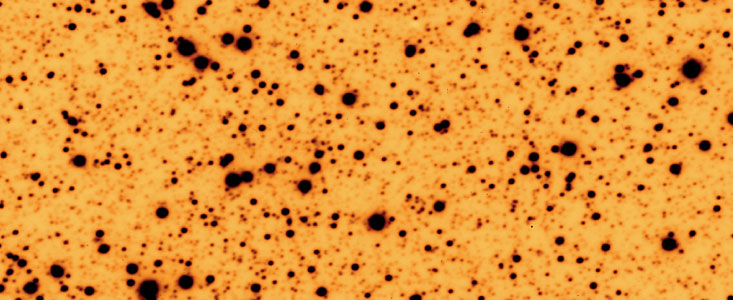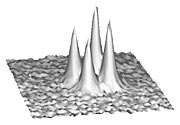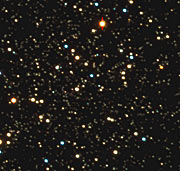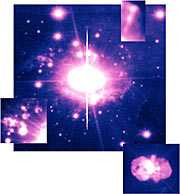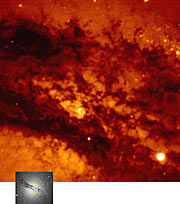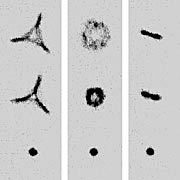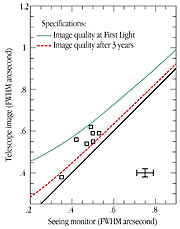Press Release
A Great Moment for Astronomy
VLT First Light Successfully Achieved
27 May 1998
The European Southern Observatory announces that First Light has been achieved with the first VLT 8.2-m Unit Telescope at the Paranal Observatory. Scientifically useful images have been obtained as scheduled, on May 25 - 26, 1998.
A first analysis of these images convincingly demonstrates the exceptional potential of the ESO Very Large Telescope. Just one month after the installation and provisional adjustment of the optics, the performance of this giant telescope meets or surpasses the design goals, in particular as concerns the achievable image quality. Exposures lasting up to 10 minutes confirm that the tracking, crucial for following the diurnal rotation of the sky, is very accurate and stable.
It appears that the concept developed by ESO for the construction of the VLT, namely an actively controlled, single thin mirror, yields a very superior performance.
In fact, the angular resolution achieved even at this early stage is unequalled by any large ground-based telescope.
The combination of large area and fine angular resolution will ultimately result in a sensitivity for point sources (e.g. stars), which is superior to any yet achieved by existing telescopes on Earth.
The present series of images demonstrate these qualities and include some impressive first views with Europe's new giant telescope. After further optimization of the optical, mechanical and electronic systems, and with increasing operational streamlining, this telescope will be able to deliver unique astronomical data of the highest quality. The commissioning and science verification phases of the complex facility including instruments will last until April 1, 1999, at which time the first visiting astronomers will be received.
The full significance of this achievement for astronomy will take time to assess.
For Europe, this is a triumph of the collaboration between nations, institutions and industries. For the first time in almost a century, European astronomers will have at their disposal the best optical/infrared telescope in the world.
We can now look forward with great expectations to the realization of many exciting research projects.
The First Light Images
Images of various celestial objects were obtained with the VLT CCD Test Camera, some of which are included in a new series, First Astronomical Images from the VLT UT1, that you can see in the right column on this page.
None have been subjected to image processing beyond flat-fielding (to remove variations of the digital detector sensitivity over the field) and cosmetic cleaning. They all display the recorded image structure, pixel by pixel. A detailed evaluation with accompanying explanations is presented in the figure captions.
1. Omega Centauri Tracking Tests
This 10-minute image demonstrates that the telescope is able to track continuously with a very high precision and thus is able to take full advantage of the frequent, very good atmospheric conditions at Paranal. The images of the stars in this southern globular cluster are very sharp (0.43 arcsec) and are perfectly round, everywhere in the field.
2. The Quadruple Clover Leaf Quasar
This 2-minute exposure of the well-known Clover Leaf quasar, a quadruple gravitational lens in which the largest distance between two components is only 1.3 arcsec, was obtained during a period of excellent seeing (0.32 arcsec) measured with a seeing monitor at the top of Paranal. The recorded angular resolution of just 0.38 arcsec demonstrates near-perfect optical quality of the telescope .
3. The Central Area of Globular Cluster M4
This is a colour composite of a field near the centre of the nearest globular cluster. At a seeing of 0.53 arcsec, the blue exposure reaches magnitude B = 24 in only 2 minutes (at signal-to-noise ratio = 5) in a bright sky. A simple extrapolation shows that B ~ 28 would be reached in a 1-hour exposure in a dark sky. The large mirror surface of the VLT UT1 and its ability to produce very sharp images, ensures that faint objects may be observed extremely efficiently.
4. Fine Structure of NGC 6302
This beautiful colour picture is a composite of three exposures through broad-band blue, green and red filters, lasting a total of 25 minutes. It shows the great complexity of this planetary nebula. It also demonstrates the exceptional efficiency with which features of faint surface brightness can be recorded with the VLT . Strong radiation from a dying star in a binary system at the centre impacts on the surrounding material that has been thrown out earlier from the system.
5) High-velocity Ejecta in Eta Carinae
This fine picture was obtained during an exposure lasting only 10 seconds. It shows fine structures around this very active object in a detail never before achieved with any ground-based telescope . In the lower insert, a short exposure of the central Homunculus Nebula (seeing 0.38 arcsec) provides a clear view of the three-dimensional structure of this bipolar object.
6. The Dust Band in Centaurus A
An amazing amount of faint details is shown in this high-resolution exposure (0.49 arcsec) of the central dust band in the nearby, southern galaxy Centaurus A, obtained through a broad-band red filter and lasting only 10 seconds. The VLT Unit Telescopes will be able to image many other galaxies in similar detail.
7. The Energetic Jet in Messier 87
The First Light took place during the night of May 25 - 26, 1998. Following a short interval of reasonable observing conditions, less optimal atmospheric conditions were encountered. The present photo, a three-colour composite (ultraviolet, blue, green) of the central region of the giant elliptical galaxy Messier 87 in the Virgo Cluster, was obtained during this night.
8. Total Optical Control
The 8.2-m main and the 1.1-m secondary mirrors of the VLT Unit Telescopes are completely computer-controlled by means of an Active Optics system. In this way, the shape of the mirror can be optimized very quickly for a given observational purpose. This sequence of 9 images illustrates how the appearance of a stellar image at the focal plane is fully controllable. Fast and thorough optical adjustment ensures the best possible optical quality at all times .
9. Image Quality of the VLT
This diagram demonstrates that First Light specifications have been fully met and, more impressively, that the actual VLT performance is sometimes already within the more stringent specifications that were expected to be fulfilled only three years from now.
The final steps before "First Light"
The final, critical testing phase commenced with the installation of the 8.2-m primary (at that time still uncoated) Zerodur mirror and 1.1-m secondary Beryllium mirror during the second half of April. The optics were then gradually brought into position during carefully planned, successive adjustments.
Due to the full integration of an advanced, active control system into the VLT concept, this delicate process went amazingly fast, especially when compared to other ground-based telescopes. It included a number of short test exposures in early May, first with the Guide Camera that is used to steer the telescope. Later, some exposures were made with the Test Camera mounted just below the main mirror at the Cassegrain Focus, in a central space inside the mirror cell. It will continue to be used during the upcoming Commissioning Phase, until the first major instruments (FORS and ISAAC) are attached to the UT1, later in 1998.
The 8.2-m mirror was successfully aluminized at the Paranal Mirror Coating facility on May 20 and was reattached to the telescope tube the day thereafter. Further test exposures were then made to check the proper functioning of the telescope mechanics, optics and electronics.
This has lead up to the moment of First Light , i.e. the time when the telescope is considered able to produce the first, astronomically useful images. Despite an intervening spell of bad atmospheric conditions, this important event took place during the night of May 25 - 26, 1998, right on the established schedule.
Links
About the Release
| Release No.: | eso9820 |
| Legacy ID: | PR 06/98 |
| Name: | Bug Nebula, Centaurus A, Cloverleaf quasar, Eta Carinae, First Light, H 1413+117, Messier 4, Messier 87, NGC 4485, NGC 5128, NGC 6302, Omega Centauri, Spinstars |
| Type: | Milky Way : Star : Type : Wolf-Rayet Milky Way : Star : Grouping : Cluster : Globular Milky Way : Nebula : Type : Planetary Local Universe : Galaxy : Type : Elliptical Local Universe : Galaxy : Component : Central Black Hole Early Universe : Galaxy : Type : Gravitationally Lensed Early Universe : Galaxy : Activity : AGN : Quasar Unspecified : Star Unspecified : Technology : Observatory : Telescope |
| Facility: | Very Large Telescope |
